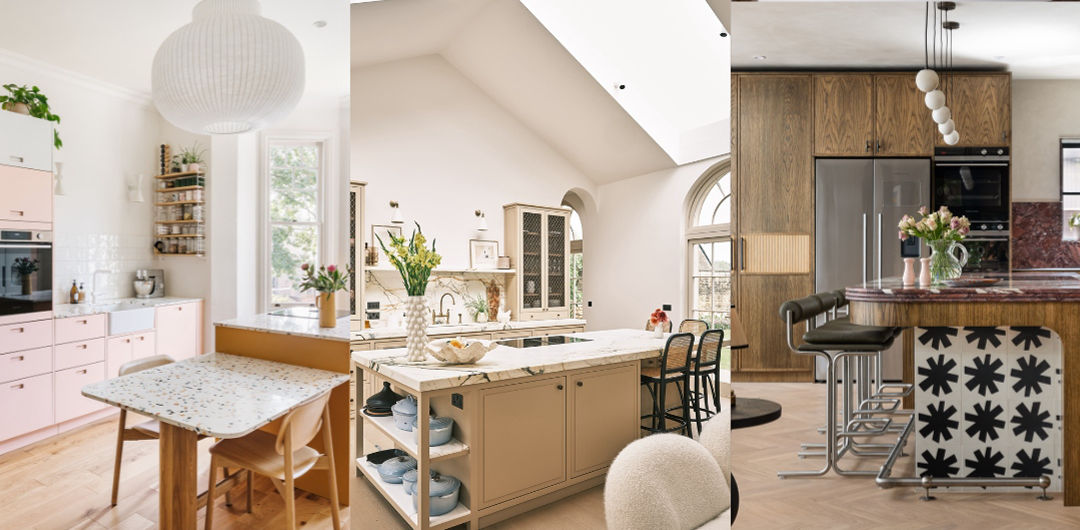Shaker, handleless, maybe both? If you’re in a quandary about which kitchen style to go for, KBB journo Charlotte Luxford reveals the factors which could help make up your mind…
So, you’re flipping through the pages of KBB or scrolling on Instagram, and you’ve spotted… the one. Your dream kitchen has a vast, marble-topped island, with a beautiful tap and pie-crust butler sink, and it all looks so spotless and chic.
Yet in reality, especially if you have young kids, that draining area is probably going to be littered with colourful plastic crockery 99% of the time. Unless you wash and dry your dishes immediately, which definitely takes some dedication.

The point I’m making is that it’s vital to really think about your design aesthetic versus how you live day to day before you choose your kitchen style. If you’re the kind of person that baulks at anything to do with cleaning and maintenance, then you may want to reconsider things like lots of open shelving that collects grease and dust (trust me, I know), or a wooden worktop that will require regular oiling.
Conversely, if you’re a bit of a neat freak, a breakfast cupboard or pantry hidden behind pocket or bi-fold doors that you can shut away to hide the mess will be a good idea.

A quick breakdown of kitchen styles
But first, we’ve summarised the range of kitchen styles so you can gauge which sounds more like your type…
- Country casual – picture painted wood cabinetry, freestanding units, farmhouse sinks complete with sink skirts, earthy colour palettes, range cookers, and open shelving. Think rustic, rambling, and eclectic, with a strong sense of nostalgia.
- Traditional – this style is about craftsmanship and extra detailing; look for beading, cornicing, and pediments… essentially, any form of decorative moulding. Given its timeless aesthetic, expect the use of classic, natural materials – picture timber, granite or marble worktops – and antique or vintage-style hardware. Glazed units are in, too.
- Contemporary – these kitchens are sleek, with handleless units and concealed appliances, mixed with one or two standout pieces, neutral or colourful, with graphic nods and maybe striking tiles to create a focal point. A strong emphasis on materials ensures they feel luxe. Think leather banquettes, designer lighting, and statement stone.
- Transitional – this is a hybrid mix of more traditional-style elements, such as Shaker style with a modern twist, blended with contemporary features like reeded cabinetry. This look is about layering textures to create interest and add character, while still being relatively pared back and modern.
- Industrial – often found in urban settings, these kitchens have a raw appeal, with exposed elements such as painted steel beams or brickwork, and perhaps concrete flooring or worktops, plus stainless steel in abundance. Expect to see reeded glass cabinetry, the use of black, and all the ‘working’ elements of the kitchen on show.
- Scandi/Japandi – this is about the subtle blend of natural materials – see raw wooden cabinetry – and a pared-back aesthetic, with slender handles (if any) and minimal clutter or appliances on show. Natural light and connection to the garden are paramount here.
Now, let’s delve into how to actually find the right one for you.

Visions and lifestyles
Essentially, you need to ensure that what you think you want actually marries up with your lifestyle – sometimes, the end result can be surprising. “Many of our clients come in dead-set on a particular look but end up with something completely different – in a really good way,” says Jamie Harding, founder of Et Lorem.
According to Jamie, the key to deciding on your kitchen style is to imagine how you’ll use the space and what kind of memories you want to create there. “That’s when you can end up with something unique and unexpected – for example, it’s not unusual for us to be asked to create a kitchen island that can be danced upon!” adds Jamie.

This is why choosing a kitchen designer you personally resonate with is so important. You want someone who can not only translate your ideas into reality, but also open you up to possibilities you may not have considered. A good designer will spend a lot of time getting to know you – how you cook, entertain, start your mornings, spend your Sundays, etc. All of that plays into how the space needs to function, and how it should feel.

Harmonious with your home
While, of course, the kitchen design should meet your lifestyle needs, many of the designers I spoke to agree it’s equally important that the style you choose is harmonious with the rest of your home’s aesthetic. “The character of your home – its era, layout, and inherent personality – should always guide your decisions,” says Charlie Smallbone, founder of Ledbury Studio. “A Georgian townhouse in Bath naturally calls for a very different approach than a converted warehouse in Shoreditch.”
And if you’re working on an extension, it makes sense to reference the period of your property and respect its original features in some way, while including all the elements required for modern-day living.

Darren Taylor, managing director at Searle & Taylor, advises looking towards classic traditional or Shaker styles if you’ve got a Georgian or Victorian property where the furniture can be designed to look as if it is part of the fabric of the building. “This often incorporates floor-to-ceiling cabinetry, or attractive cornices on the top of tall units, with door fronts designed to conceal modern appliances,” he says.
Design elements
Rather than monolithic islands, cook’s tables with cleverly concealed appliances and electrical points are having a moment in period-style kitchens, providing a nostalgic look with all the practicality required to run a modern kitchen.

When it comes to a period or country kitchen, the star of the show is often a statement range cooker, providing that authentic heritage feel. The only downside is that cooking takes place facing the wall, which may not tally with your desire for a sociable kitchen, so it’s key to work out which is more of a priority for you.
A bank of appliances including a steam oven, a combination microwave, and warming drawers can look impressive housed within tall cabinetry in any kitchen style, with a sleek vented induction hob on the island working well in kitchens where entertaining is a regular occurrence.

“If the kitchen is in a home dating from the 20th century onwards, then a contemporary linear, handleless version may complement the architecture, with neutral colour choices suiting earlier and art deco properties, while more dramatic palettes come into their own in mid-century homes or younger,” adds Darren.

Transitional kitchens are trending
However, these days, many homeowners aren’t opting for just one clear-cut style – the trend for the ‘transitional’ kitchen has had a huge influence on the market, and it’s common practice to marry multiple styles in the kitchen, for both aesthetic and practical reasons.

“Opting for a cohesive mix of traditional and modern elements allows the owner to create a transitional look that will be sympathetic to all styles of property,” says Ria Parkinson, sales promoter for Neolith.
A transitional kitchen might feature slimline Shaker-style cabinetry paired with handleless units or a reeded island, and perhaps a modern-style range cooker – I’ve even seen Wood Works Brighton be bold enough to actually put the range in the island, which sounds slightly bonkers, but it works.

Breaking the mould
Sometimes it pays to break the mould completely; there are a fair few designers who have successfully installed striking contemporary kitchens within grand Grade II listed homes and yet they don’t feel remotely out of place. The secret is to pay attention to context and the bones of the building, as well as match the level of craftsmanship – it has to be on par, otherwise the overall effect will fall short.
For example, Jane Powell, design manager at Kitchen Architecture, points out they’ve installed clean-lined Bulthaup cabinetry in a period townhouse, but paired it with rich oak flooring and a natural stone worktop to echo the heritage of the building without it feeling like a pastiche.

Conversely, they’ve also put a classic kitchen from their Teddy Edwards range in a contemporary Cotswolds barn conversion, with honed marble worktops and aged brass hardware to bring ‘just the right note of quiet luxury’, made to suit the scale and drama of the open-plan space.
“Ultimately, the best kitchen designs balance respect for the home’s character with your unique needs, creating a space that’s both beautiful and highly functional,” says creative design director Tom Howley, of the eponymous kitchen company.







